Thermal Energy Storage Using Hybrid Nanofluid Phase Change Material (PCM) Based on Waste Sludge Incorp Rated ZnO/α-Fe2O3
Abstract
1. Introduction
2. Experimental Section
2.1. Synthesis of ZnO/α-Fe2O3 Nanoparticles
2.2. Characterization Study
2.3. Experimental Methodology
3. Results and Discussion
3.1. Structural and Morphological Characterization
3.2. Performance of PCM Analysis
3.2.1. Melting/Solidification Cycles
3.2.2. Heat Profile Yield
3.2.3. Overall Heat and System Performance
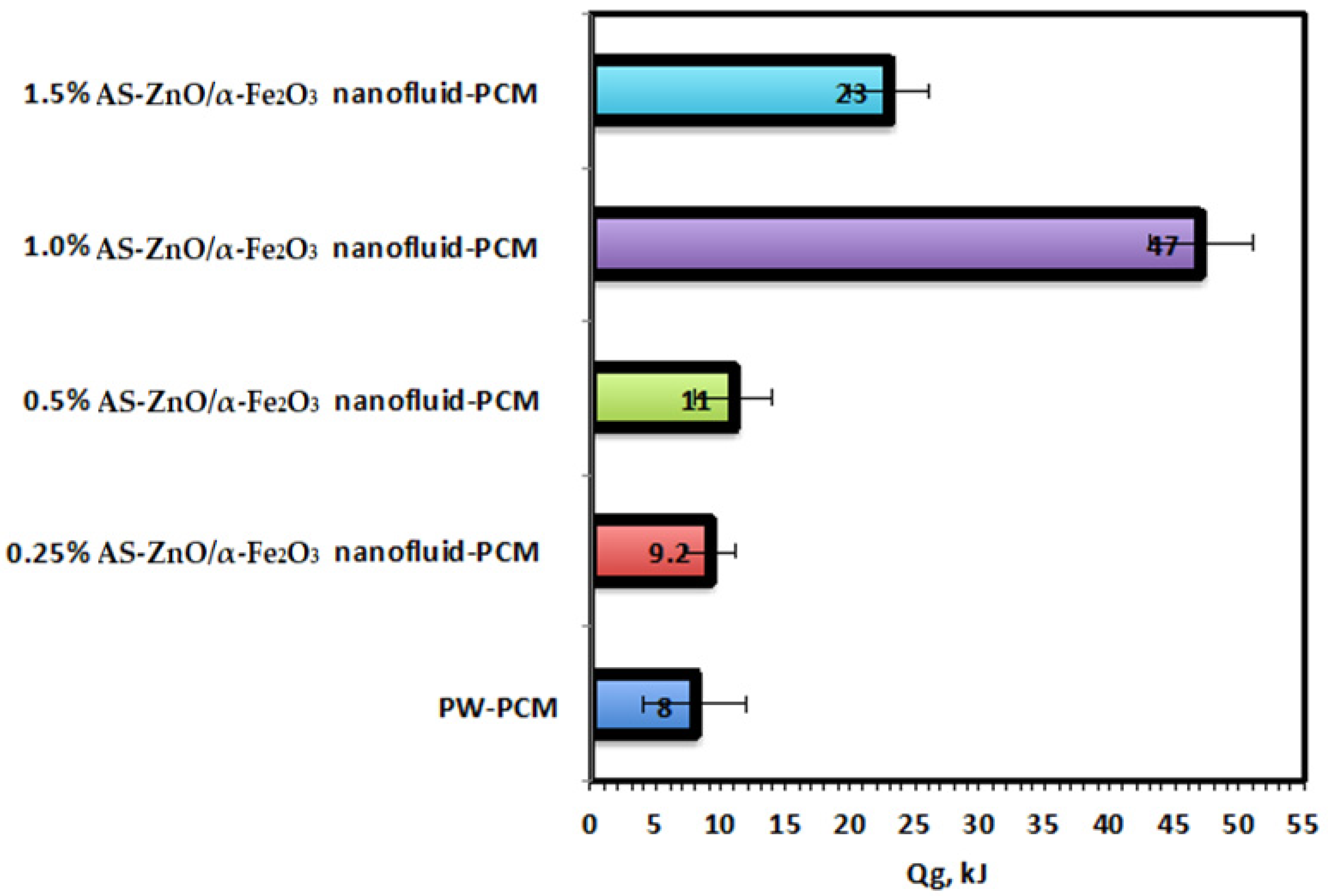
| Nanomaterial | Addition Weight (%) | Key Results | Application | Ref. |
|---|---|---|---|---|
| AS-ZnO/α-Fe2O3 | 1.0% | Efficiency increased 93% | Heating | Current investigation |
| Al2O3 | 2.0% | Temperature enhanced with 1.5 °C | Heating | [39] |
| SiO2 | NA | Efficiency increased 9% | Heating | [40] |
| TiO2 | 1.0% | Reduce in PCM heat by 0.5% | NA | [12] |
| CuO | 0.02% | Increase in thermal conductivity | Heating | [41] |
| ZnO | 3.0% | Thermal conductivity increased | Heating | [42] |
| ZnO/SiO2 | 3.0% | Efficiency increased 19% | Heating | [43] |
| ZSM-12 | NA | Temperature enhanced with 21 °C | Heating | [44] |
| Carbon | 1.0% | Thermal conductivity increased 49% | Heating | [45] |
| Carbon | 10% | Thermal conductivity increased 31% | Photovoltaic cells | [38] |
| Carbon nanotube | 5% | Thermal conductivity increased 87% | Heating | [21] |
| Ag | 10% | Thermal conductivity increased | Heating | [46] |
| carbon nanofiber | 10% | Thermal conductivity enhancement 31% | photovoltaic cells | [47] |
| MgO | 1% | Thermal conductivity enhancement 17% | Supercooling | [48] |
| nanographene | Thermal conductivity enhancement 10% | Water heating | [49,50] | |
| PCM containing mortar | A reduction of almost 10 °C | Ventlation | [51] | |
| PCM in the gypsum | Thermal dynamic characteristics improved 45% | Thermal inertia of buildings | [52] | |
| Double layer PCM | Energy saving 38% | Building’s energy efficiency and thermal comfort | [53] |
4. Conclusions
Author Contributions
Funding
Data Availability Statement
Conflicts of Interest
Nomenclature
| PCMs | Phase change material |
| TES | thermal energy storage |
| XRD | X-ray diffraction analysis |
| TEM | transmission electron microscopy |
| STHE | Shell-and-tube heat exchanger |
| LHS | Latent heat thermal storing |
| SHS | Sensible heat storing |
| TCS | thermochemical heat energy storage |
| PW | Paraffin wax |
| Tω | Melting temperatures, °C |
| Tα | Solidification temperatures, °C |
| Tβ | Gained temperature after storing, °C |
| Mass flow rate of heat transfer fluid, g/s | |
| θ | Temperature range between inlet and outlet water |
| Cw | Specific heat capacity of heat transfer fluid, kJ/kg K |
| ƒ | Overall system efficiency, % |
References
- McGillicuddy, R.D.; Thapa, S.; Wenny, M.B.; Gonzalez, M.I.; Mason, J.A. Metal–Organic Phase-Change Materials for Thermal Energy Storage. Am. Chem. Soc. 2020, 142, 19170–19180. [Google Scholar] [CrossRef] [PubMed]
- White, M.; Kahwaji, S.; John, A.; Noël, J. Recent advances in phase change materials for thermal energy storage. Chem. Commun. 2024, 60, 1690–1706. [Google Scholar] [CrossRef]
- Nazir, H.; Batool, H.; Francisco, J.; Osorio, B.; Isaza-Ruiz, M.; Xu, V.; Vignarooban, K.; Phelan, P.; Inamuddin, A.M.; Kannan, A.M. Recent developments in phase change materials for energy storage applications: A review. Inter. J. Heat. Mass. Trans. 2019, 129, 491–523. [Google Scholar] [CrossRef]
- Bianco, N.; Caliano, M.; Fragnito, A.; Iasiello, M.; Mauro, G.; Mongibello, L. Thermal analysis of micro-encapsulated phase change material (MEPCM)-based units integrated into a commercial water tank for cold thermal energy storage. Energy 2023, 266, 126479. [Google Scholar] [CrossRef]
- Zubair, A.Q.; Hafiz, M.A.; Shahab, K. Recent advances on thermal conductivity enhancement of phase change materials for energy storage system: A review. Int. J. Heat Mass Transf. 2018, 127, 838–856. [Google Scholar]
- Navarro, L.; Solé, A.; Martín, M.; Barreneche, C.; Olivieri, L.; Tenorio, J.A.; Cabeza, L.F. Benchmarking of useful phase change materials for a building application. Energy Build. 2019, 182, 45–50. [Google Scholar] [CrossRef]
- Ahangari, M.; Maerefat, M. An innovative PCM system for thermal comfort improvement and energy demand reduction in building under different climate conditions. Sustain. Cities Soc. 2019, 44, 120–129. [Google Scholar] [CrossRef]
- Sharif, M.; Al-Abidi, A.; Mata, S.; Sopian, K.; Ruslan, M.; Sulaiman, M.; Rosli, M. Review of the application of phase change material for heating and domestic hot water systems. Renew. Sustain. Energy Rev. 2015, 42, 557–568. [Google Scholar] [CrossRef]
- NematpourKeshteli, A.; Iasiello, M.; Langella, G.; Bianco, N. Increasing melting and solidification performances of a phase change material-based flat plate solar collector equipped with metal foams, nanoparticles, and wavy wall-Y-shaped surface. Energy Convers. Manag. 2023, 291, 117268. [Google Scholar] [CrossRef]
- Liu, Y.; Wang, J.; Su, C.; Geng, S.; Gao, Y.; Peng, Q. Nucleation rate and supercooling degree of water-based graphene oxide nanofluids. Appl. Therm. Eng. 2017, 115, 1226–1236. [Google Scholar]
- Wong-Pinto, L.-S.; Milian, Y.; Ushak, S. Progress on use of nanoparticles in salt hydrates as phase change materials. Renew. Sus. Energy Rev. 2020, 122, 109727. [Google Scholar] [CrossRef]
- Reddy, D.; Prasad, R.; Senthilkumar, R.; Lakshmanarao, G.; Krishnan, S.; Prasad, N. A critical review on thermal energy storage materials and systems for solar applications. AIMS Energy 2019, 7, 507–526. [Google Scholar] [CrossRef]
- Teng, T.-P.; Yu, C. Characteristics of phase-change materials containing oxide nano-additives for thermal storage. Nano Res. Lett. 2012, 7, 611. [Google Scholar] [CrossRef] [PubMed]
- Ali, H.; Abedin, M.; Rosen, A. A critical review of thermochemical energy storage systems. Open Renew. Energy J. 2011, 4, 42–46. [Google Scholar]
- Man, X.; Lu, H.; Xu, Q.; Wang, C.; Ling, Z. Review on the thermal property enhancement of inorganic salt hydrate phase change materials. J. Energy Storage 2023, 72, 108699. [Google Scholar] [CrossRef]
- Zondag, A.H. Chapter 6—Sorption Heat Storage. In Solar Energy Storage; Academic Press: Cambridge, MA, USA, 2015; pp. 135–154. [Google Scholar]
- Luo, L.; Le Pierres, N. Chapter 3—Innovative Systems for Storage of Thermal Solar Energy in Building. In Solar Energy Storage; Academic Press: Cambridge, MA, USA, 2015; pp. 27–62. [Google Scholar]
- Blanco, M.J.; Santigosa, L.R. Advances in Concentrating Solar Thermal Research and Technology; Woodhead Publishing Series in Energy; Woodhead Publishing: Sawston, UK, 2017; pp. 213–246. [Google Scholar] [CrossRef]
- Zeng, J.; Cao, Z.; Yang, D.; Sun, L.; Zhang, L. Thermal conductivity enhancement of Ag nanowires on an organic phase change material. J. Therm. Ana Cal. 2010, 101, 385–389. [Google Scholar] [CrossRef]
- Zhu, Q.; Ong, P.J.; Goh, S.H.A.; Reuben, J.Y.; Wang, S.; Liu, Z.; Loh, X.J. Recent advances in graphene-based phase change composites for thermal energy storage and management. Nano Mater. Sci. 2023; in press. [Google Scholar] [CrossRef]
- Xu, C.; Fang, G. Review on thermal conductivity improvement of phase change materials with enhanced additives for thermal energy storage. J. Energy Storage 2022, 51, 104568. [Google Scholar] [CrossRef]
- Ong, P.J.; Png, Z.M.; Yun, X.; Debbie, S.; Xu, J.W. Surface modification of microencapsulated phase change materials with nanostructures for enhancement of their thermal conductivity. Mater. Chem. Phys. 2021, 277, 125438. [Google Scholar] [CrossRef]
- Das, N.; Takata, Y.; Kohno, M.; Harish, S. Melting of graphene based phase change nanocomposites in vertical latent heat thermal energy storage unit. Appl. Therm. Eng. 2016, 107, 101–113. [Google Scholar] [CrossRef]
- Xiong, T.; Zheng, L. Kwok Wei Shah, Nano-enhanced phase change materials (NePCMs): A review of numerical simulations. Appl. Therm. Eng. 2020, 178, 115492. [Google Scholar] [CrossRef]
- Vinosha, P.A.; Das, S.J. Investigation on the role of pH for the structural, optical and magnetic properties of cobalt ferrite nanoparticles and its effect on the photo-fenton activity. Mater. Today Proc. 2018, 5, 8662–8671. [Google Scholar] [CrossRef]
- Xuan, Y.; Li, Q.; Yang, G. Synthesis and magnetic properties of Mn–Zn ferrite nanoparticles. J. Mag. Mag. Mater. 2007, 312, 464–469. [Google Scholar] [CrossRef]
- Talam, S.; Karumyri, S.R.; Gunnam, N. Synthesis, Characterization, and Spectroscopic Properties of ZnO Nanoparticles. Nanotechnology 2012, 2012, 372505. [Google Scholar] [CrossRef]
- Li, R.; Zhou, Y.; Duan, X. A novel composite phase change material with paraffin wax in tailings porous ceramics. Appl. Therm. Eng. 2019, 151, 115–123. [Google Scholar] [CrossRef]
- Muthoka, M.J.; Zhang, X.; Xu, X. Study on Thermophysical Properties of Nanofluid Based Composite Phase Change Material for Low Temperature Application. Energy Procedia 2017, 142, 3313–3319. [Google Scholar] [CrossRef]
- Liu, M.; Saman, W.; Bruno, F. Review on storage materials and thermal performance enhancement techniques for high temperature phase change thermal storage systems. Renew. Sus. Energy Rev. 2012, 16, 2118–2132. [Google Scholar] [CrossRef]
- Pise, A.T.; Waghmare, A.V.; Talandage, V.G. Heat Transfer Enhancement by Using Nanomaterial in Phase Change Material for Latent Heat Thermal Energy Storage System. Asian J. Eng. Appl. Technol. 2013, 2, 52–57. [Google Scholar] [CrossRef]
- Chieruzzi, M.; Miliozzi, A.; Crescenzi, T.; Torre, L.; Kenny, J.M. A New Phase Change Material Based on Potassium Nitrate with Silica and Alumina Nanoparticles for Thermal Energy Storage. Nanoscale Res Lett. 2015, 10, 273. [Google Scholar] [CrossRef] [PubMed]
- Harikrishnan, S.; Deenadhayalan, M.; Kalaiselvam, S. Experimental investigation of solidification and melting characteristics of composite PCMs for building heating application. Energy Convers. Manag. 2014, 86, 864–872. [Google Scholar] [CrossRef]
- Fang, X.; Fan, L.; Ding, Q.; Wang, X.; Yao, X.L.; Hou, J.F.; Yu, Z.; Chen, G.; Hu, Y.; Cen, K. Increased Thermal Conductivity of Eicosane-Based Composite Phase Change Materials in the Presence of Graphene Nanoplatelets. Energy Fuels 2013, 27, 4041–4047. [Google Scholar] [CrossRef]
- Emara, K.; Aliwa, H.; Abdellatif, O.E.; Abd El-hameed, H.M. Experimental investigation for a hybrid aluminum oxide nanofluid-phase change material photovoltaic thermal system based on outdoor test conditions. J. Energy Storage 2022, 50, 104261. [Google Scholar] [CrossRef]
- Narayanan, S.; Kardam, S.A.; Kumar, V.; Bhardwaj, N.; Madhwal, D.; Shukla, P.; Kumar, A.; Verma, A.; Jain, V.K. Development of sunlight-driven eutectic phase change material nanocomposite for applications in solar water heating. Resour.-Effic. Technol. 2017, 3, 272–279. [Google Scholar]
- Karunamurthy, K.; Murugumohan, K.; Suresh, S. Use Of Cuo Nano-Material for The Improvement of Thermal Conductivity and Performance of Low Temperature Energy Storage System of Solar Pond. Dig. J. Nanomater. BioStruct. 2012, 7, 1833–1841. [Google Scholar]
- Sushobhan, B.; Kar, S. Thermal modeling of melting of nano based phase change material for improvement of thermal energy storage. Energy Proced. 2017, 109, 385–392. [Google Scholar] [CrossRef]
- Altohamy, A.A.; Abd Rabbo, M.F.; Sakr, R.Y.; Attia, A.A. Effect of water based Al2O3 nanoparticle PCM on cool storage performance. Appl. Therm. Eng. 2015, 84, 331–338. [Google Scholar] [CrossRef]
- Bondareva, S.; Gibanov, N.; Sheremet, M. Computational Study of Heat Transfer inside Di_erent PCMs Enhanced by Al2O3 Nanoparticles in a Copper Heat Sink at High Heat Loads. Nanomaterials 2020, 10, 284. [Google Scholar] [CrossRef]
- Tony, M.A. From biomass residue to solar-thermal energy: The potential of bagasse as a heat storage material. Euro-Mediterr. J. Environ. Integr. 2020, 5, 17. [Google Scholar] [CrossRef]
- Bahiraei, F.; Fartaj, A.; Nazri, G.-A. Experimental and numerical investigation on the performance of carbon-based nanoenhanced phase change materials for thermal management applications. Energy Convers Manag. 2017, 153, 115–128. [Google Scholar] [CrossRef]
- Tony, M.A. Recent frontiers in solar energy storage via nanoparticles enhanced phase change materials: Succinct review on basics, applications and their environmental aspects. Energy Storage 2021, 3, e238. [Google Scholar] [CrossRef]
- Tony, M.A.; Mansour, S. Sunlight-driven organic phase change material-embedded nanofiller for latent heat solar energy storage. Inter. J. Environ. Sci. Technol. 2020, 17, 709–720. [Google Scholar] [CrossRef]
- Tony, M.A. Nexus approach: ZSM12 derived from industrial waste and organic wax pair for microencapsulated solar energy storage system. Energy Sources Part A Recovery Util. Environ. Eff. 2021, 43, 1–19. [Google Scholar] [CrossRef]
- Ramakrishnan, S.; Wang, X.; Sanjayana, J.; Wilson, J. Heat transfer performance enhancement of paraffin/expanded perlite phase change composites with graphene nano-platelets. Energy Proced. 2017, 105, 4866–4871. [Google Scholar] [CrossRef]
- Al Ghossein, R.; Hossain, M.; Khodadadi, J. Experimental determination of temperature-dependent thermal conductivity of solid eicosane-based silver nanostructure- enhanced phase change materials for thermal energy storage. Inter. J. Heat. Mass. Trans. 2017, 107, 697–711. [Google Scholar] [CrossRef]
- Soibam, J. Numerical Investigation of a Heat Exchanger Using Phase Change Materials. Master’s Thesis, Norwegian University of Science and Technology NTNU, Trondheim, Norway, 2017. [Google Scholar]
- Li, R.; Zhou, Y.; Duan, X. Nanoparticle Enhanced Paraffin and Tailing Ceramic Composite Phase Change Material for Thermal Energy Storage. Sustain. Energy Fuels 2020, 9, 4547–4557. [Google Scholar] [CrossRef]
- Muthoka, M.; Zhang, X.; Xu, X. Experimental investigation on supercooling, thermal conductivity and stability of nanofluid based composite phase change material. J. Energy Storage 2018, 17, 47–55. [Google Scholar]
- Figueiredo, A.; Silva, T.; Gonçalves, M.; Samagio, A. Application of Novel Phase Change Material Constructive Solution for Thermal Regulation of Passive Solar Buildings. Buildings 2024, 14, 493. [Google Scholar] [CrossRef]
- Marín, P.E.; Ushak, S.; de Gracia, A.; Cabeza, L.F. Characterisation of the COMFORTBOARD Gypsum Board for Thermal Energy Storage in Buildings. J. Energy Storage 2024, 77, 109850. [Google Scholar] [CrossRef]
- Askari, M.; Jahangir, M.H. Evaluation of Thermal Performance and Energy Efficiency of a Trombe Wall Improved with Dual Phase Change Materials. Energy 2023, 284, 128587. [Google Scholar] [CrossRef]


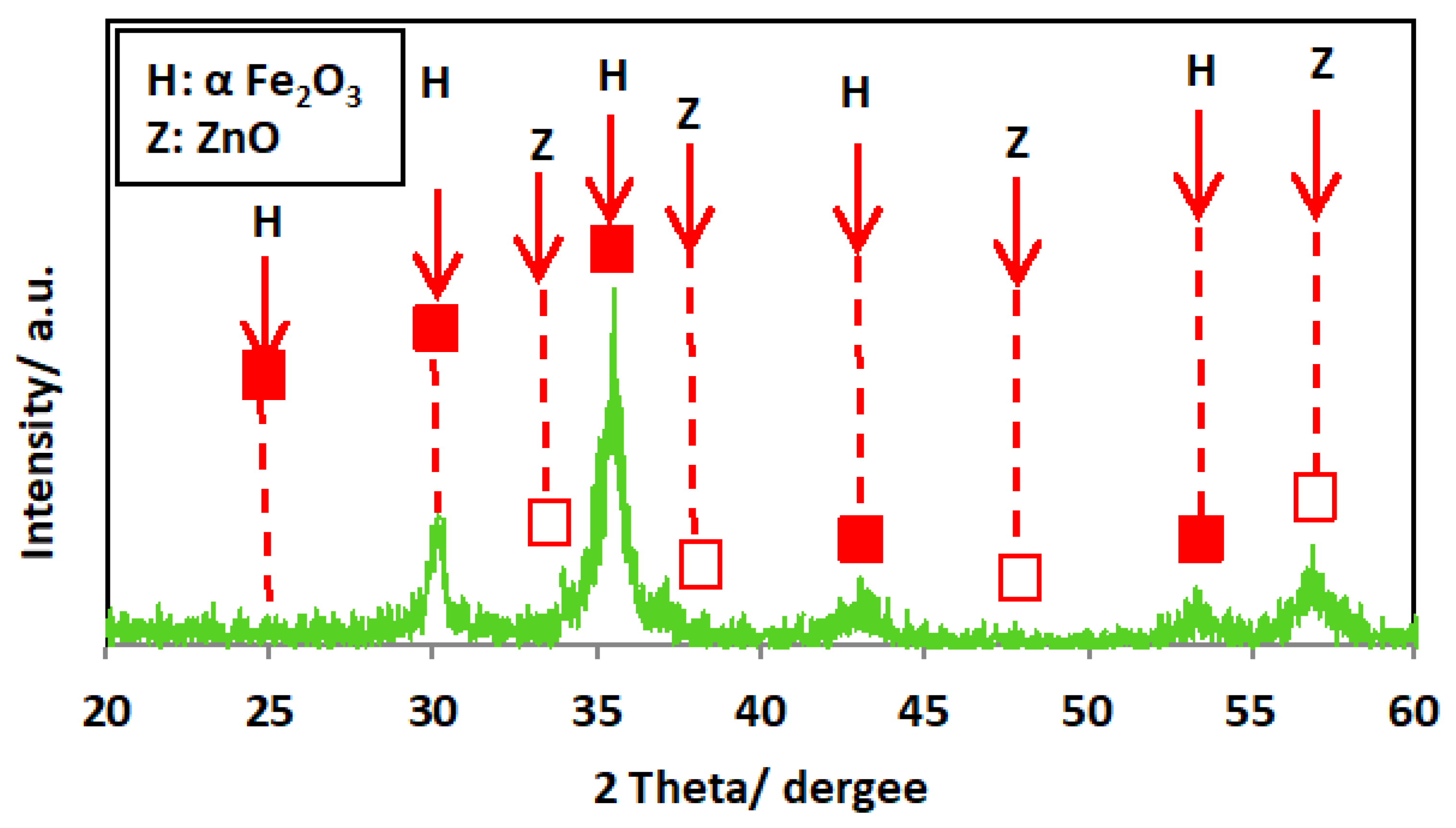
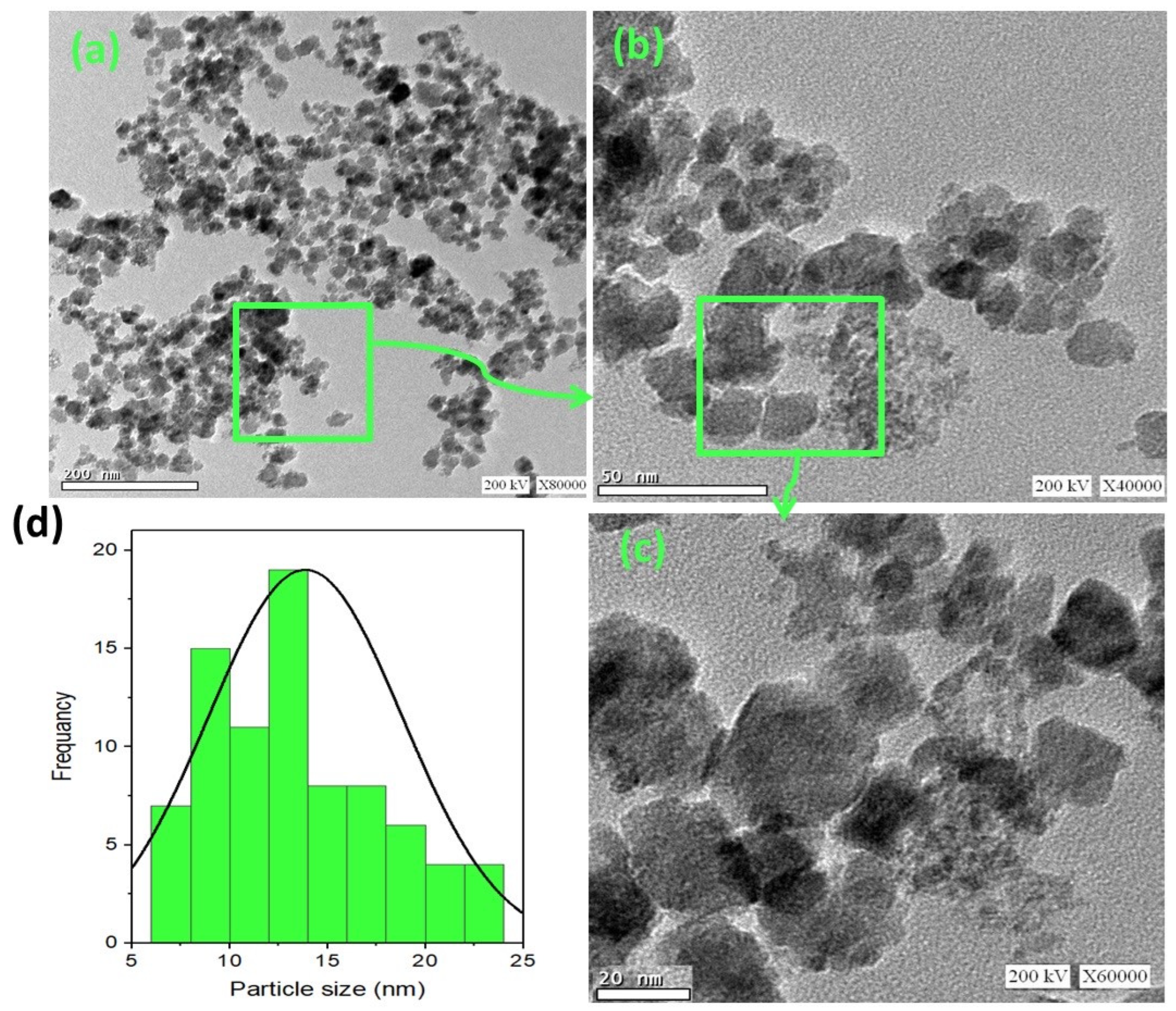
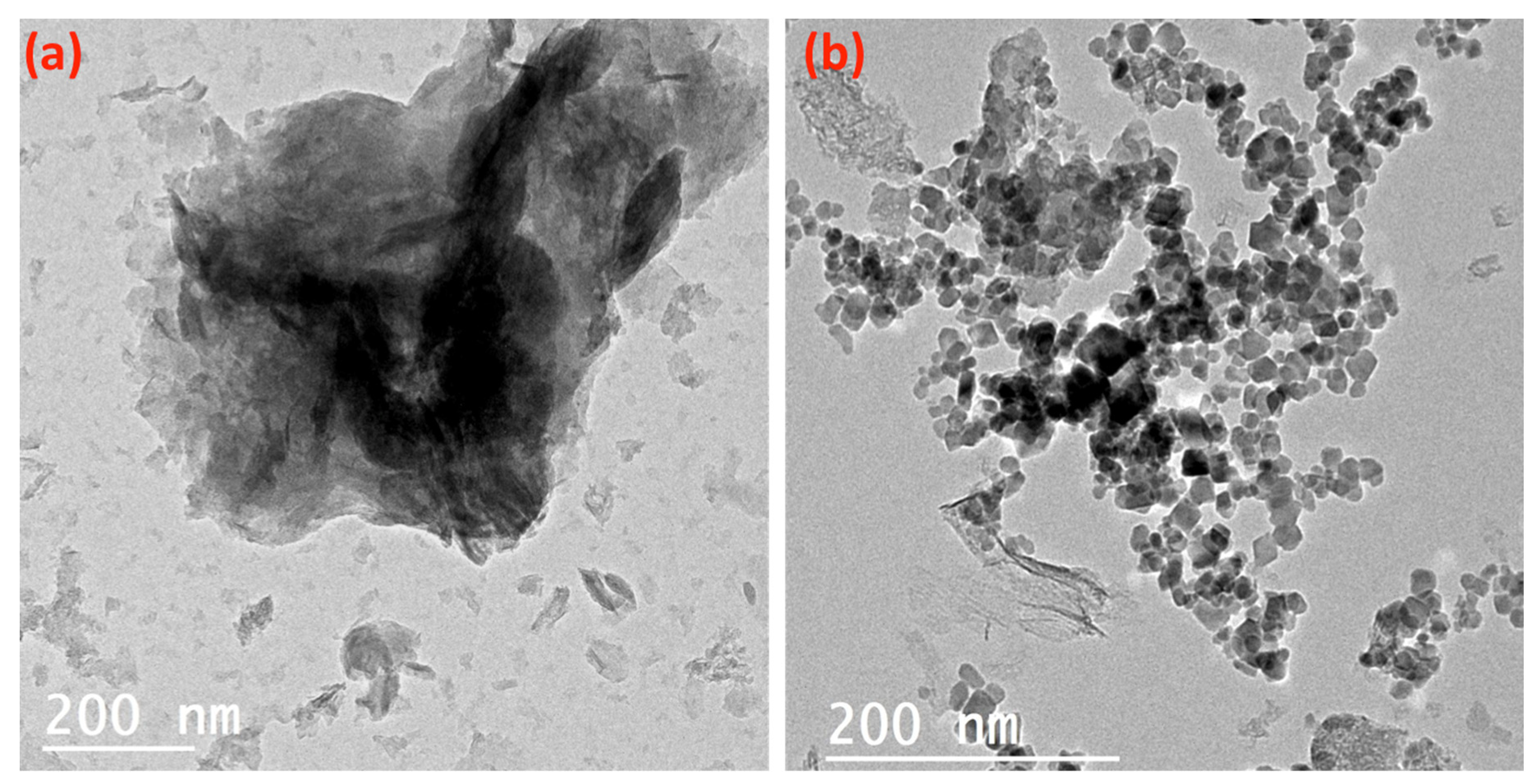
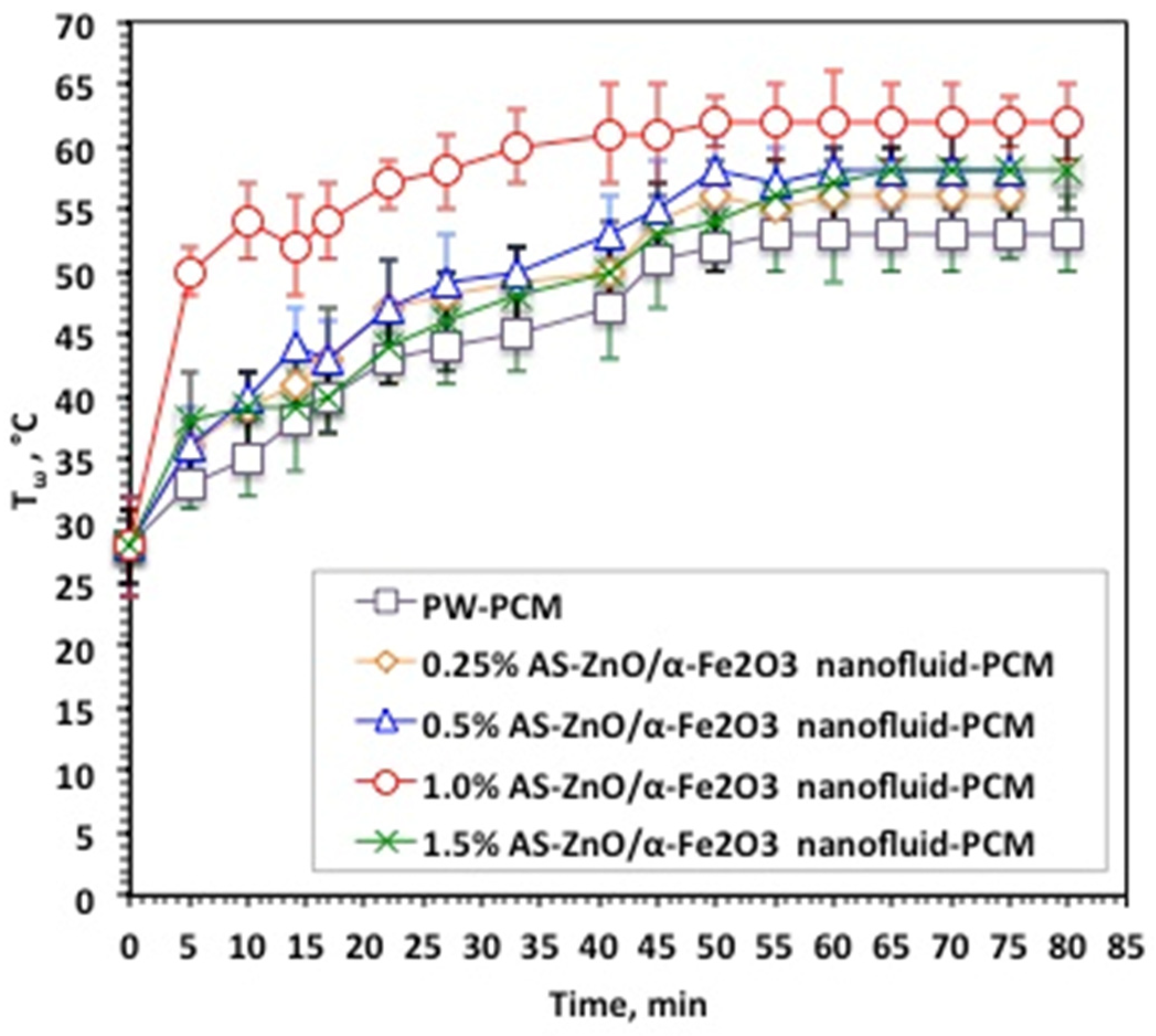


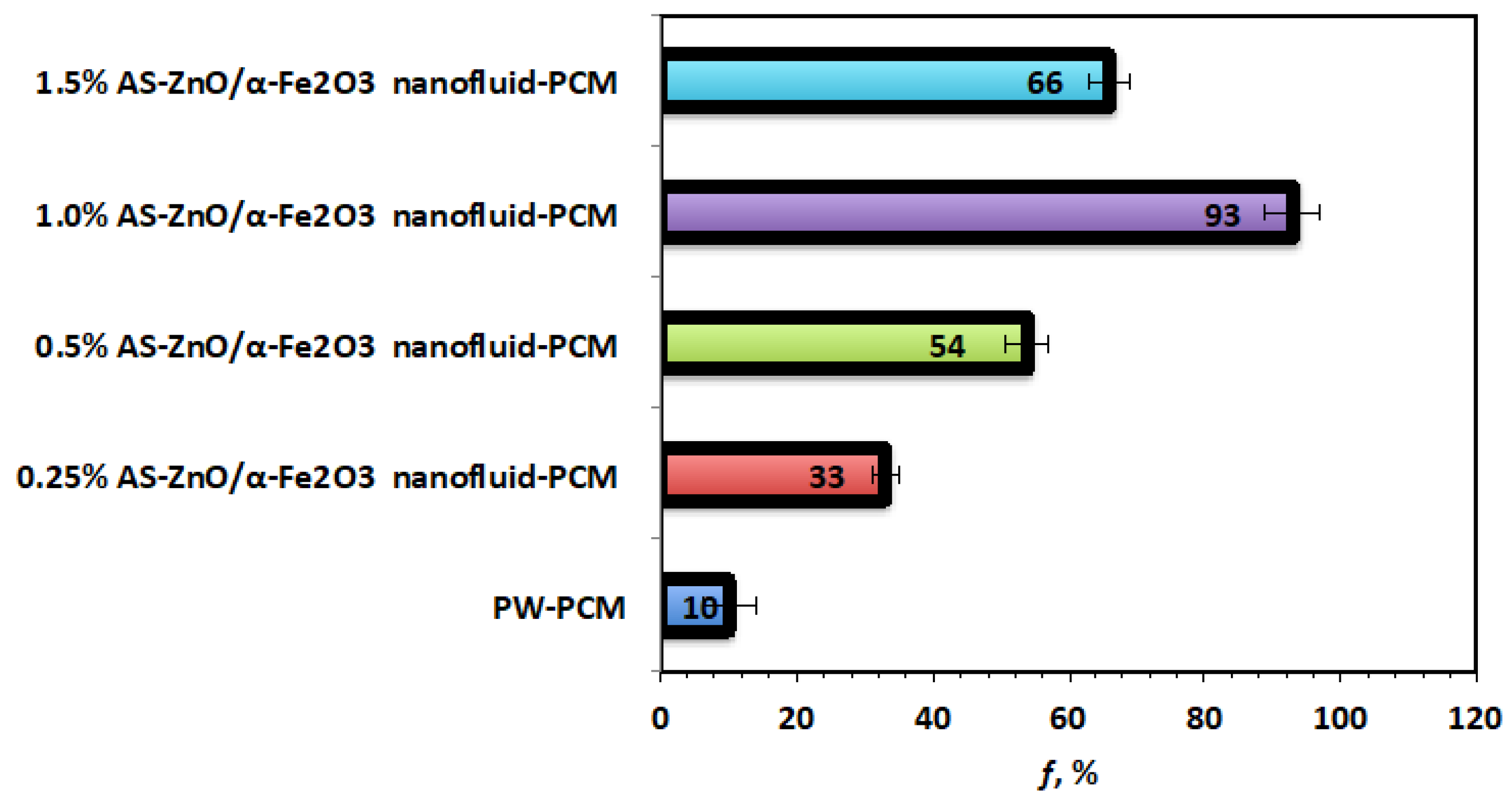
Disclaimer/Publisher’s Note: The statements, opinions and data contained in all publications are solely those of the individual author(s) and contributor(s) and not of MDPI and/or the editor(s). MDPI and/or the editor(s) disclaim responsibility for any injury to people or property resulting from any ideas, methods, instructions or products referred to in the content. |
© 2024 by the authors. Licensee MDPI, Basel, Switzerland. This article is an open access article distributed under the terms and conditions of the Creative Commons Attribution (CC BY) license (https://creativecommons.org/licenses/by/4.0/).
Share and Cite
Hassan, E.A.; Tony, M.A.; Awad, M.M. Thermal Energy Storage Using Hybrid Nanofluid Phase Change Material (PCM) Based on Waste Sludge Incorp Rated ZnO/α-Fe2O3. Nanomaterials 2024, 14, 604. https://doi.org/10.3390/nano14070604
Hassan EA, Tony MA, Awad MM. Thermal Energy Storage Using Hybrid Nanofluid Phase Change Material (PCM) Based on Waste Sludge Incorp Rated ZnO/α-Fe2O3. Nanomaterials. 2024; 14(7):604. https://doi.org/10.3390/nano14070604
Chicago/Turabian StyleHassan, Ehssan Ahmed, Maha A. Tony, and Mohamed M. Awad. 2024. "Thermal Energy Storage Using Hybrid Nanofluid Phase Change Material (PCM) Based on Waste Sludge Incorp Rated ZnO/α-Fe2O3" Nanomaterials 14, no. 7: 604. https://doi.org/10.3390/nano14070604
APA StyleHassan, E. A., Tony, M. A., & Awad, M. M. (2024). Thermal Energy Storage Using Hybrid Nanofluid Phase Change Material (PCM) Based on Waste Sludge Incorp Rated ZnO/α-Fe2O3. Nanomaterials, 14(7), 604. https://doi.org/10.3390/nano14070604







